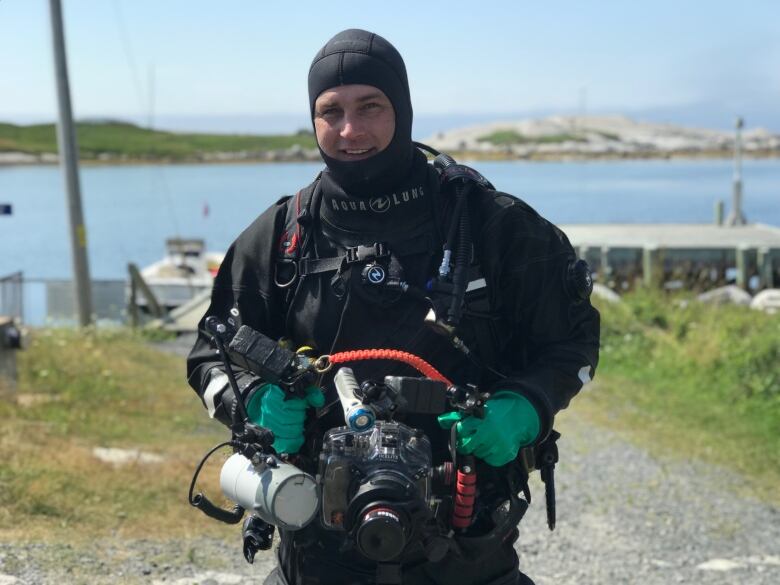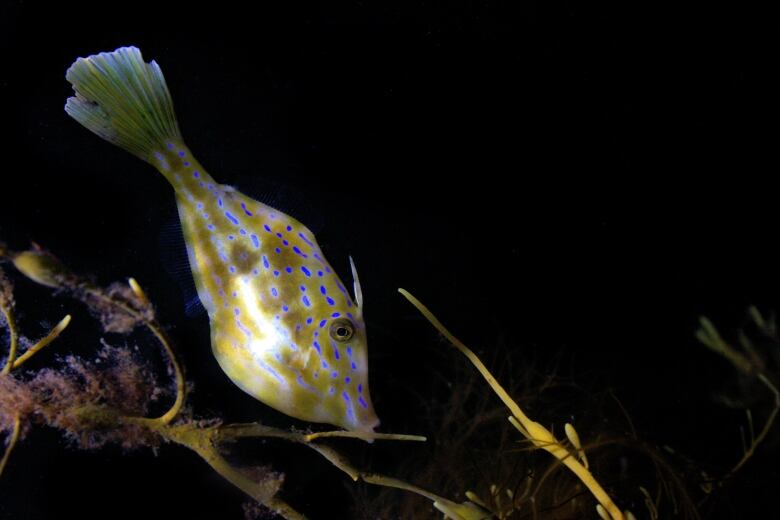As ocean temperatures rise, photographer seeing more warm-water fish off Nova Scotia
Scuba diver and photographer Lloyd Bond has documented increasing numbers of tropical fish near Halifax

Scuba diver Lloyd Bond thought the first time he saw a spotfinbutterfly fish under a Nova Scotia wharf it would be a one-off.
"It's like, oh wow, I saw a butterfly fish and a seahorse in the same year," the Halifax residentsaid. "Then the following year I [saw]the same thing,and it was twice as many."
Bond, who has been scuba diving around Nova Scotia for 23 years, says in the last three years he's seen increasing numbers of not only butterfly fish and seahorses, but cornet fish, trigger fish, puffer fishand many other species rarely seen inCanadian waters.
The fish are often vibrantly coloured or have fluorescent markings, and some have ranges that include the Caribbean and Gulf of Mexico to Brazil.

"They're usually about the size of a quarter, a loonie, something like that. They're quite small," Bondsaid.
Bond doesn't just look at the fish; he photographs them during dives several times a week. He's had dozens of sightings in a single yearat different locations around Halifax, includingat Paddys Head wharf and Prospect wharf near Peggys Cove.

Canadian scientists agree ocean temperatures have increased over the last century due to climate change caused by humans.In its April 2019 report Canada's Changing Climate,Environment and Climate Change Canada saidthe Earth'soceans are projected to continue to warm over the coming century due to greenhouse gas emissions.
Measurements taken by Fisheries and Oceans Canada have shownocean temperatures rising sharply starting in 2010, with some areas such as Georges Basin a deep-water hole in the Gulf of Maine havingthewarmest temperature on record for that region last July.

So far in 2019, DFO measurements do not show abnormally high water temperatures in the area, but research scientists such asDave Hebert of Fisheries and Oceans Canada are continuing to analyze how the warm waters of the Gulf Stream interact with the Arctic waters of the Labrador Current.
Hebert says pulses of warm, subtropical waters are pushing cold Arctic waters back.
"Those two waters mix together off of Nova Scotia. It's really [dependent on] how much warm water versus how much cold water," he said. "Think of how you mix hot and cold water in your bathtub.
"It's not like it just turned really warm it's like a pulse comes on, and it sort of builds up over time."

Hebert says the fish are being carried north on those warm water pulses.
"They're just being transported with the water. It's not like they're coming up here because it's warm; they're coming with the warm water," he said.

Marine ecologist Boris Worm, a professor at Dalhousie University in Halifax, says while the presence of the fish themselves isn't likely to disrupt ecosystems, there's the possibility that invasive predatory species and warm water diseases won't be far behind.

"What has a larger impact is the warming water itself, which changes the composition of the phytoplankton and ... it really reorganizes the food web," he explained.
Warmer waters may also eventually bring in fresh diseases to Nova Scotia waters.
"It's a general rule of thumb that a warmer world is a sicker world," he said. "More micro-organisms can survive in warmer waters for longer periods of time."
He cites the collapse of the lobster fishery off southern Rhode Island that occurred after a shell disease "that probably came in with warmer waters."
For now, though, it's unlikely the tropical fish stand a chance at competing with the hardier local species.
"It definitely seems unnatural," Bond said. "You're really happy to see them but it's kind of bittersweet because you know they're going to die off the first cold snap. As soon as the water gets cold, usually a couple of days later everything's gone."
With files from The Canadian Press












_(720p).jpg)


 OFFICIAL HD MUSIC VIDEO.jpg)
.jpg)



























































































